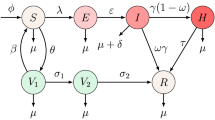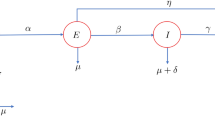Abstract
Measles, a highly contagious infection caused by the measles virus, is a major public health problem in China. The reported measles cases decreased dramatically from 2004 to 2012 due to the mandatory measles vaccine program started in 2005 and the goal of eliminating measles by 2012. However, after reaching its lowest level in 2012, measles has resurged again since 2013. Since the monthly data of measles cases exhibit a seasonally fluctuating pattern, based on the measles model in Earn et al. (Science 287:667–670, 2000), we propose a susceptible, exposed, infectious, and recovered model with periodic transmission rate to investigate the seasonal measles epidemics and the effect of vaccination. We calculate the basic reproduction number \({\mathcal {R}}_{0}\), analyze the dynamical behavior of the model, and use the model to simulate the monthly data of measles cases reported in China. We also carry out some sensitivity analysis of \({\mathcal {R}}_{0}\) in the terms of various model parameters which shows that measles can be controlled and eventually eradicated by increasing the immunization rate, improving the effective vaccine management, and enhancing the awareness of people about measles.







Similar content being viewed by others
References
Anderson RM, May RM (1983) Vaccination against rubella and measles: quantitative investigations of different policies. J Hyg Camb 90:259–325
Anderson RM, May RM (1991) Infectious diseases of humans: dynamics and control. Oxford University Press, Oxford
Bacaër N, Guernaoui S (2006) The epidemic threshold of vector-borne diseases with seasonality. J Math Biol 53:421–436
Bai Z, Liu D (2015) Modeling seasonal measles transmission in China. Commun Nonlinear Sci Numer Simul 25:19–26
Bartlett MS (1957) Measles periodicity and community size. J R Stat Soc A 120:48–70
Bartlett MS (1960) The critical community size for measles in the U.S. J R Stat Soc A 123:37–44
Bolker BM, Grenfell BT (1993) Chaos and biological complexity in measles dynamics. Proc R Soc Lond B 251:75–81
Bolker BM, Grenfell BT (1996) Impact of vaccination on the spatial correlation and persistence of measles dynamics. Proc Natl Acad Sci USA 93:12648–12653
Chinese Center for Disease Control and Prevention (2017) Measles. http://www.chinacdc.cn/jkzt/crb/mz/
Conlan AJK, Grenfell BT (2007) Seasonality and the persistence and invasion of measles. Proc R Soc B 274:1133–1141
Dietz K (1976) The incidence of infectious diseases under the influence of seasonal fluctuations. In: Berger J et al (eds) Mathematical models in medicine, lecture notes biomathematics, vol 11. Springer, New York, pp 1–11
Earn DJD, Rohani P, Bolker BM, Grenfell BT (2000) A simple model for complex dynamical transitions in epidemics. Science 287:667–670
Ferguson NM, Nokes DJ, Anderson RM (1996) Dynamical complexity in age-structured models of the transmission of the measles virus: epidemiological implications at high levels of vaccine uptake. Math Biosci 138:101–130
Ferrari MJ, Grais RF, Bharti N et al (2008) The dynamics of measles in sub-Saharan Africa. Nature 451:679–684
Greenhalgh D (1988) Threshold and stability results for an epidemic model with an age-structured meeting rate. IMA J Math Appl Med Biol 5:81–100
Hamer WH (1906) Epidemic disease in England—the evidence of variability and of persistency of type, the Milroy Lectures III. Lancet 167(4307):733–739
Hethcote HW (1983) Measles and rubella in the United States. Am J Epidemiol 117:2–13
Hethcote HW (1988) Optimal ages for vaccination for measles. Math Biosci 89:29–52
Keeling MJ, Grenfell BT (1997) Disease extinction and community size: modeling the persistence of measles. Science 275:65–67
London WP, Yorke JA (1973) Recurrent outbreaks of measles, chickenpox and mumps I: seasonal variation in contact rates. Am J Epidemiol 98:453–468
Ma C, An Z, Hao L, Cairns KL, Zhang Y (2011) Progress toward measles elimination in the People’s Republic of China, 2000–2009. J Infect Dis 204:S447–S454
Ma C, Hao L, Zhang Y, Su Q, Rodewald L (2014) Monitoring progress towards the elimination of measles in China: an analysis of measles surveillance data. Bull World Health Organ 92:340–347
McLean AR, Anderson RM (1988) Measles in developing countries. Part II. The predicted impact of mass vaccination. Epidemiol Inf 100:419–442
National Bureau of Statistics of China (2016) China Demographic Yearbook of 2016. http://www.stats.gov.cn/tjsj/ndsj/2016/indexch.htm
National Health and Family Planning Commission of PRC (2017) Bulletins, http://www.nhfpc.gov.cn/jkj/pqt/new_list.shtml
Pang L, Ruan S, Liu S, Zhao Z, Zhang X (2015) Transmission dynamics and optimal control of measles epidemics. Appl Math Comput 256:131–147
Perko L (2001) Differential equations and dynamical systems, 3rd edn. Springer, New York
Perry RT, Gacic-Dobo M, Dabbagh A, Mulders MN, Strebel PM, Okwo-Bele JM (2014) Global control and regional elimination of measles, 2000–2012. MMWR Morb Mortal Wkly Rep 63:103–107
Schenzle D (1984) An age-structured model of pre- and pose-vaccination measles transmission. Math Med Biol 1:169–191
Smith H, Waltman P (1995) The theory of the chemostat. Cambridge University Press, Cambridge
Soper HE (1929) The interpretation of periodicity in disease prevalence. J R Stat Soc 92(1):34–73
Thieme H (1992) Convergence results and a Poincaré–Bendixson trichotomy for asymptotically autonomous differential equations. J Math Biol 30:755–763
Tudor DW (1985) An age-dependent epidemic model with application to measles. Math Biosci 73:131–147
Wang W, Zhao X-Q (2008) Threshold dynamics for compartmental epidemic models in periodic environments. J Dyn Differ Equ 20:699–717
Wang L, Zeng G, Lee LA, Yang Z, Yu J (2003) Progress in accelerated measles control in the People’s Republic of China, 1991–2000. J Infect Dis 187:S252–S257
World Health Organization (2009) Progress towards the 2012 measles elimination goal in WHO’s Western Pacific Region, 1990–2008. Wkly Epidemiol Rec 84:271–279
World Health Organization (2017) Measles, WHO Fact sheet No. 286, Updated March 2017.http://www.who.int/mediacentre/factsheets/fs286/en/
Yang W, Wen L, Li S-L, Chen K, Zhang W-Y, Shaman J (2017) Geospatial characteristics of measles transmission in China during 2005–2014. PLoS Comput Biol 13(4):e1005474. https://doi.org/10.1371/journal.pcbi.1005474
Yorke JA, London WP (1973) Recurrent outbreaks of measles, chickenpox and mumps II: systematic differences in contact rates and stochastic effects. Am J Epidemiol 98:469–482
Zhang F, Zhao X (2007) A periodic epidemic model in a patchy environment. J Math Anal Appl 325:496–516
Zhang J, Jin Z, Sun GQ, Sun XD, Ruan S (2012) Modeling seasonal rabies epidemics in China. Bull Math Biol 74:1226–1251
Zhao X-Q (2007) Dynamical systems in population biology. Springer, New York
Zheng X, Zhang N, Zhang X, Hao L, Su Q et al (2016) Investigation of a measles outbreak in China to identify gaps in vaccination coverage, routes of transmission, and interventions. PLoS ONE 11(12):e0168222. https://doi.org/10.1371/journal.pone.0168222
Acknowledgements
Research was partially supported by the National Natural Science Foundation of China (Nos. 11471133, 11771168, 11871235) and National Science Foundation (No. DMS-1412454).
Author information
Authors and Affiliations
Corresponding author
Rights and permissions
About this article
Cite this article
Huang, J., Ruan, S., Wu, X. et al. Seasonal transmission dynamics of measles in China. Theory Biosci. 137, 185–195 (2018). https://doi.org/10.1007/s12064-018-0271-8
Received:
Accepted:
Published:
Issue Date:
DOI: https://doi.org/10.1007/s12064-018-0271-8




